Empowering Elementary Students with Community-Based Engineering: A Teacher’s Experience in a Rural School District
Abstract
1. Introduction
2. Literature Review
Engineering Education in Elementary Schools
3. Theoretical Framework
Community-Based Engineering Education
4. Methods
4.1. Participant
4.2. Description of PD
4.3. Data Sources
4.4. Data Analysis
5. Findings
5.1. What Meaningful Practices Occur in the Implementation of Engineering and Community-Based Engineering Lessons in an Elementary Teacher’s Classroom?
5.1.1. Connecting Scientific Inquiry with Engineering Design
They [engineering and science] kind of blend well together. And that’s what I was trying to do. I was trying not to keep engineering so separate from science, because I felt like, that’s kind of how I’ve taught it in the past, like, oh, here’s all the science standards I have to teach, [and] will do engineering when I get done with those. And it’s like, a fun add on project, as opposed to like embedding it throughout. But yeah, I think, you know, kind of teaching them to, like, ask questions and be curious and go through those, you know, science inquiry lessons can lead into what you do as an engineer.(post-teaching interview)
From day one, the expectations in this classroom are it’s okay to make a mistake, it’s okay to fail. Like, we talk about our mistakes, we celebrate mistakes, like when students, you know, make a mistake. And I’ll ask them, like, are you okay with me sharing this mistake? It’s a wonderful mistake, we can learn from it, like I talked it up…And so I think that that whole kind of like classroom culture lends itself into the kind of work that they can do with engineering because, I mean, one of the things that I noticed year to year is that even at fourth grade, they’re so afraid to fail, like they’re afraid to get something wrong…we talk a lot about that how, like, with scientists and engineers that they fail, or that they have a question, and they think that they have a certain answer, but then they do the experiment where they do the work or whatever. And they find out that they were wrong. And so then, they revise their thinking.(post-teaching interview)
5.1.2. Building Background Knowledge
At this age, just to have the background of like, you know, the different problems that they [students] looked at and examined. And that’s kind of how I did all of the units, like whatever science unit I was teaching. I tried to have some kind of engineering design activity that related to the science, but it was usually after we had done kind of like the lessons to build the background knowledge and content first.
it’s really important at this age, because I think it [lesson] has to be open ended enough where they [students], they are the ones doing the discovery, and they’re the ones working through it. But you know, I think if you leave it too wide open and don’t have the support in place, then I think that they flounder too much. I guess it’s more of like, if you can scaffold and kind of guide them through where it’s like, I’m not giving you the answers. But like, here’s the things that we’re going to investigate and look at. It gives them the opportunity to have like, more productive struggle, rather than just sitting there not knowing where to start or what to.
5.1.3. Implementing Community-Based Engineering Lessons
I had discovered, or I had, you know, talked with Dr. X [community member in [Town]], and we had talked about how [State] has the most amount of ice jam flooding in the lower 48 states. So then that kind of led into, like, well, what do they do about these types of floods, which then led me to finding a floodplain engineer. And so, he had come in and showed the kids like a model, like a simulation of like, different floodplains and what happens. And so then from there, then we created the lesson about looking at, you know, the different types of rivers and what can you do, and, you know, just kind of by talking with the engineer.(post-teaching interview)
5.1.4. Classroom Culture and Expectations
Holly (00:20:46): Can you tell us, make a prediction, use that sentence, “I predict.” And tell us how you think that the rocks and sand ended up on top of that layer of volcanic ash that we have.
Student (00:21:08–00:21:44): I predict that winds blew rocks and sands.
Holly (00:21:44): Ok, so you think that winds picked up rocks and sands in the mountain ranges over here and blew them to Nebraska. (00:21:51) Does the map support that opinion?
Student (00:22:07): Yeah. Rocks could have been over lava…
5.2. What Are an Elementary Teacher’s Beliefs about Teaching/Integrating Engineering and Community-Based Engineering Lessons?
5.2.1. Community-Based Projects Had a Significant Impact on Students’ Engagement and Self-Perception as Engineers
The difference that I saw between engineering lessons and the community-based engineering lessons where they were solving their community issue, was the way they talked about themselves, like, Oh, I’m doing this, this is fun. Like, I like this project, versus the community issues that we were solving was I’m an engineer.(post-teaching interview)
5.2.2. Engineering Lessons Are Aligned with the Curriculum and State Standards
The curriculum, they’re one of our, you know, main standards for fourth grade, structure function in information processing. And so, I have a whole unit…it focuses on animals and plants, and I think it could just fit in nicely with that.(post-PD interview)
5.2.3. Principal Support Facilitates the Integration of Engineering into Classrooms
5.2.4. Understanding the Local Community Context Is Crucial in Designing Community-Based Engineering Lessons
6. Discussion
7. Conclusions
Author Contributions
Funding
Institutional Review Board Statement
Informed Consent Statement
Data Availability Statement
Conflicts of Interest
References
- Hammack, R.J.; Lux, N.; Gannon, P.; Hacker, D.; LaMeres, B.J.; Wiehe, B.; Boz, T. Connecting Classroom Curriculum to Local Contexts to Enhance Engineering Awareness in Elementary Youth. In Proceedings of the Annual American Society for Engineering Education Conference, Baltimore, MD, USA, 25–28 June 2023. [Google Scholar]
- National Academy of Engineering and National Research Council. Technically Speaking: Why All Americans Need to Know More About Technology; The National Academies Press: Washington, DC, USA, 2002. [Google Scholar] [CrossRef]
- National Research Council [NRC]. A Framework for K-12 Science Education: Practices, Crosscutting Concepts, and Core Ideas; National Academy Press: Washington, DC, USA, 2012. [Google Scholar]
- Prinsley, R.; Johnson, E. Transforming STEM Teaching in Australian Primary Schools: Everybody’s Business; Office of the Chief Scientist: Sydney, Australia, 2015. [Google Scholar]
- Royal Academy of Engineering. Learning to Teach Engineering in the Primary and KS3 Classroom; United Kingdom. 2018. Available online: http://www.raeng.org.uk/tinkering (accessed on 5 March 2023).
- Carnegie Corporation of New York. The Need to Align Teaching with Next Generation Science Standards. Available online: https://www.carnegie.org/our-work/article/need-curriculum-based-professional-learning-align-teacher-practice-next-generation-science-standards/ (accessed on 10 December 2022).
- American Society for Engineering Education [ASEE] & Advancing Excellence in P-12 Engineering Education [AEEE]. A Framework for P-12 Engineering Learning: A defined and Cohesive Educational Foundation for P-12 Engineering; American Society for Engineering Education: Washington, DC, USA, 2020. [Google Scholar]
- Banilower, E.R.; Smith, P.S.; Malzahn, K.A.; Plumley, C.L.; Gordon, E.M.; Hayes, M.L. Report of the 2018 NSSME+; Horizon Research, Inc.: Chapel Hill, NC, USA, 2018. [Google Scholar]
- Cunningham, C.M.; Kelly, G.J. Epistemic practices of engineering for education. Sci. Educ. 2017, 101, 486–505. [Google Scholar] [CrossRef]
- Lachapelle, C.P.; Cunningham, C.M.; Jocz, J.; Kay, A.E.; Phadnis, P.; Wertheimer, J.; Arteaga, R. Engineering is Elementary: An Evaluation of Years 4 through 6 Field Testing; Museum of Science: Boston, MA, USA, 2011. [Google Scholar]
- Cunningham, C.M. Engineering is elementary. Bridge Link. Eng. Soc. 2009, 39, 11–17. [Google Scholar]
- Yoon, S.Y.; Dyehouse, M.; Lucietto, A.M.; Diefes-Dux, H.A.; Capobianco, B.M. The effects of integrated science, technology, and engineering education on elementary students’ knowledge and identity development. Sch. Sci. Math. 2014, 114, 380–391. [Google Scholar] [CrossRef]
- Brophy, S.; Klein, S.; Portsmore, M.; Rogers, C. Advancing engineering education in P-12 classrooms. J. Eng. Educ. 2008, 97, 369–387. [Google Scholar] [CrossRef]
- Sneider, C.I.; Ravel, M.K. Insights from two decades of P-12 engineering education research. J. Pre-College Eng. Educ. Res. 2021, 11, 5. [Google Scholar] [CrossRef]
- Frank, C.R.; Uy, F.L. Ethnography for Teacher Education. J. Teach. Educ. 2004, 55, 269–283. [Google Scholar] [CrossRef]
- Frank, C. Ethnographic Eyes: A Teacher’s Guide to Classroom Observation; Heinemann: Portsmouth, NH, USA, 1999. [Google Scholar]
- Kant, J.M.; His Horse Is Thunder, W.; Burckhard, S.R.; Meyers, R.T. Why don’t more American Indians become engineers in South Dakota? Int. J. Eng. Soc. Justice Peace 2015, 4, 17–34. [Google Scholar] [CrossRef]
- Tonso, K.L. On the Outskirts of Engineering: Learning Identity, Gender, and Power via Engineering Practice; Sense Publishers: Zuid-Holland, The Netherlands, 2007. [Google Scholar]
- Tan, E.; Calabrese Barton, A.; Benavides, A. Engineering for sustainable communities: Epistemic tools in support of equitable and consequential middle school engineering. Sci. Educ. 2019, 103, 1011–1046. [Google Scholar] [CrossRef]
- Chiu, J.L.; Fick, S.J.; McElhaney, K.W.; Alozie, N.; Fujii, R. Elementary teacher adaptations to engineering curricula to leverage student and community resources. J. Pre-College Eng. Educ. Res. 2021, 11, 5. [Google Scholar] [CrossRef]
- Mejia, J.A.; Drake, D.; Wilson-Lopez, A. Changes in Latino/a Adolescents’ Engineering Self-efficacy and Perceptions of Engineering After Addressing Authentic Engineering Design Challenges. In Proceedings of the Annual American Society for Engineering Education Conference, Seattle, WA, USA, 14–17 June 2015. [Google Scholar] [CrossRef]
- Calabrese Barton, A.; Tan, E. Designing for rightful presence in STEM: Community ethnography as pedagogy as an equity-oriented design approach. J. Learn. Sci. 2019, 28, 616–658. [Google Scholar] [CrossRef]
- Calabrese Barton, A.; Schenkel, K.; Tan, E. Collaboratively engineering for social justice in sixth grade STEM. J. Res. Sci. Teach. 2021, 58, 1010–1040. [Google Scholar] [CrossRef]
- Yin, R. Case Study Research: Design and Methods; Sage Publications: Thousand Oaks, CA, USA, 2017. [Google Scholar]
- Hammack, R.; Lux, N.; Gannon, P.; LaMeres, B. Using Ethnography to Enhance Elementary Teachers’ Readiness to Teach Engineering. In Proceedings of the Annual American Society for Engineering Education Conference, Virtual, 26–29 July 2021. [Google Scholar]
- Hammack, R.; Stanton, C.R.; Boyle, J. "Step Outside": A portrait of an exemplary rural K-8 science educator. J. Res. Sci. Teach. 2022, 60, 544–567. [Google Scholar] [CrossRef]
- Capobianco, B.M.; Radloff, J. Exploring the use of approximations of practice in the context of elementary teachers’ attempts at implementing engineering design-based science teaching. In Proceedings of the Annual American Society for Engineering Education, Salt Lake City, UT, USA, 24–27 June 2018. [Google Scholar]
- Sawada, D.; Piburn, M.; Falconer, K.; Turley, J.; Benford, R.; Bloom, I. Reformed Teaching Observation Protocol; (RTOP) (ACEPT Technical Report No. IN00-1); Arizona Collaborative for Excellence in the Preparation of Teachers: Tempe, AZ, USA, 2000. [Google Scholar]
- Campbell, J.L.; Quincy, C.; Osserman, J.; Pedersen, O.K. Coding In-depth Semistructured Interviews: Problems of Unitization and Intercoder Reliability and Agreement. Sociol. Methods Res. 2013, 42, 294–320. [Google Scholar] [CrossRef]
- Birt, L.; Scott, C.D.; Campbell, C.; Walter, F. Member checking: A tool to enhance trustworthiness or merely a nod to validation? Qual Health Res. 2016, 26, 1802–1811. [Google Scholar] [CrossRef] [PubMed]
- Saldaña, J. The Coding Manual for Qualitative Researchers, 4th ed.; SAGE Publications: Thousand Oaks, CA, USA, 2021. [Google Scholar]
- Maxwell, J.A.; Miller, B.A. Categorizing and connecting strategies in qualitative data analysis. In Handbook of Emergent Methods; Leavy, P., Hesse-Biber, S.N., Eds.; Guilford Press: New York, NY, USA, 2008; pp. 461–477. [Google Scholar]
- Gonzalez, N.; Moll, L.C.; Floyd-Tenery, M.; Rivera, A.; Rendon, P.; Gonzales, R.; Amanti, C. Teacher Research on Funds of Knowledge: Learning from Households; Center for Research on Education, Diversity and Excellence: Santa Cruz, CA, USA, 1993; Available online: https://escholarship.org/uc/item/5tm6x7cm (accessed on 10 December 2022).
- Moll, L.C.; Amanti, C.; Neff, D.; Gonzalez, N. Funds of knowledge for teaching: Using a qualitative approach to connect homes and classrooms. Theory Into Pract. 1992, 31, 132–141. [Google Scholar] [CrossRef]
- Watson-Gegeo, K.A. Classroom Ethnography. In Encyclopedia of Language and Education; Hornberger, N.H., Corson, D., Eds.; Springer: Dordrecht, The Netherlands, 1997; Volume 8. [Google Scholar]
- Zaharlick, A. Ethnography in anthropology and its value for education. Theory Into Pract. 1992, 31, 116–125. [Google Scholar] [CrossRef]
- Hammack, R.; Lux, N.; Gannon, P.; Wiehe, B.; Moonga, M.; LaMeres, B. Using Blended Modalities for Engineering Education Professional Development: Supporting Elementary Teachers’ Development of Community-Focused Engineering Curricula. In Proceedings of the Annual American Society for Engineering Education Conference, Minneapolis, MN, USA, 26–26 June 2022. [Google Scholar]
- Radloff, J.; Capobianco, B.; Dooley, A. Elementary teachers’ positive and practical risk-taking when teaching science through engineering design. J. Pre-College Eng. Educ. Res. 2019, 9, 4. [Google Scholar] [CrossRef]
- Douglas, K.A.; Rynearson, A.; Yoon, S.Y.; Diefes-Dux, H. Two elementary schools’ developing potential for sustainability of engineering education. Int. J. Technol. Des. Educ. 2016, 26, 309–334. [Google Scholar] [CrossRef]
- Hammack, R.; Ivey, T. Elementary teachers’ perceptions of K-5 engineering education and perceived barriers. J. Eng. Educ. 2019, 108, 503–522. [Google Scholar] [CrossRef]
- Martin, M.J.; Diem, S.J.; Karwat, D.M.A.; Krieger, E.M.; Rittschof, C.C.; Bayon, B.; Aghazadeh, M.; Asensio, O.; Zeilkova, T.J.; Garcia-Cazarin, M.; et al. The climate is changing. Engineering education needs to change as well. J. Eng. Educ. 2022, 111, 740–746. [Google Scholar] [CrossRef]
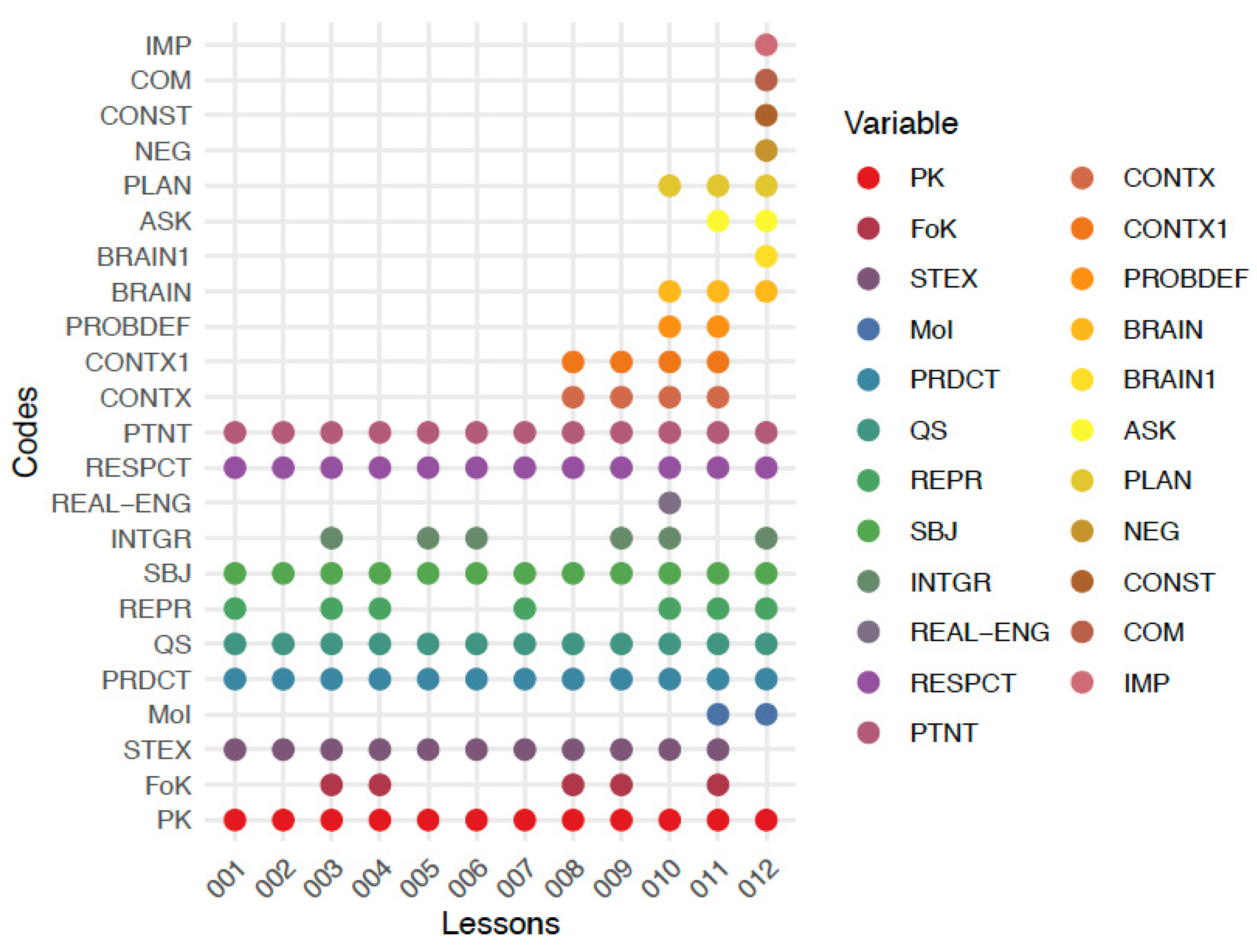
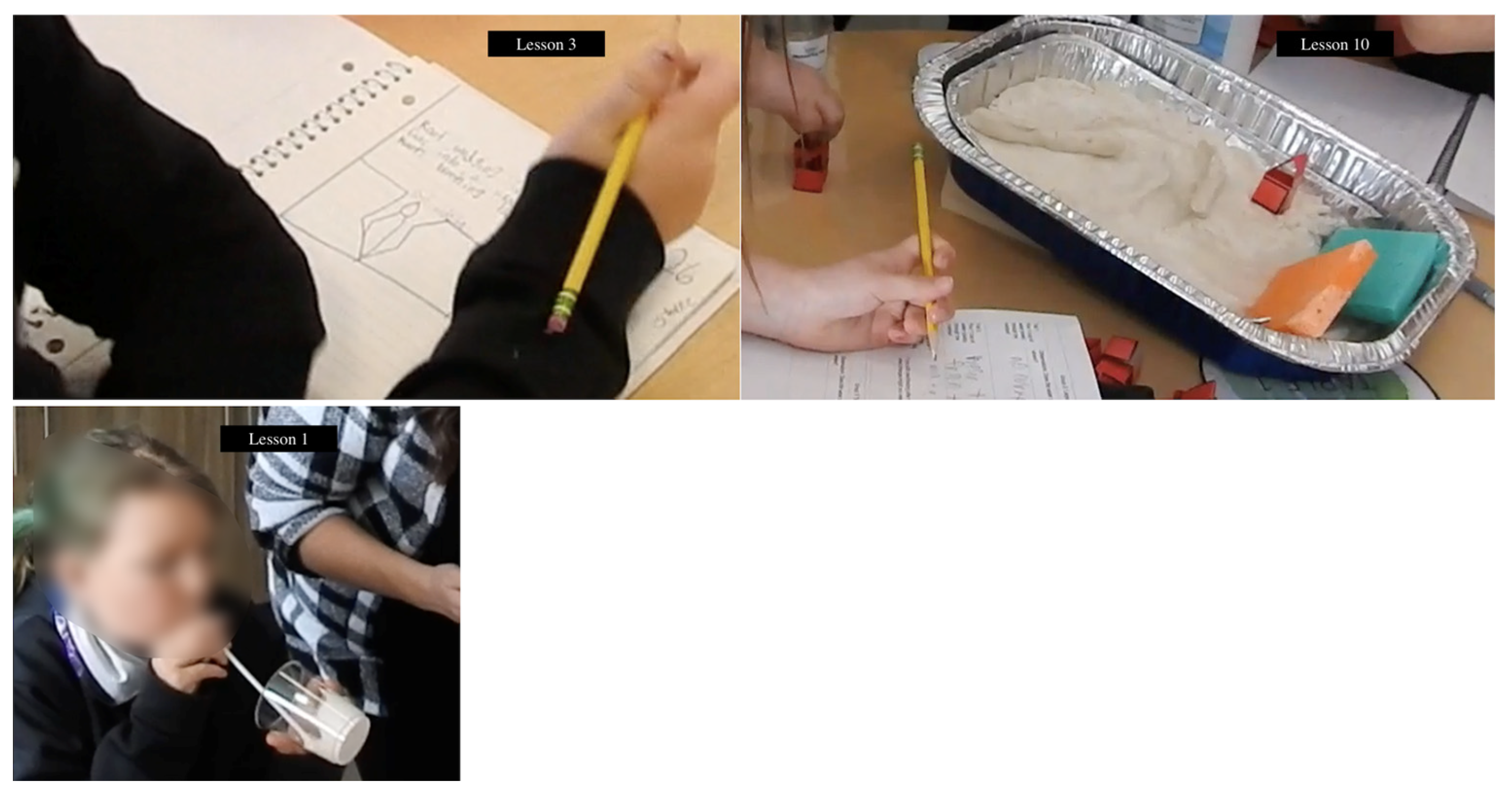
| Lesson | Duration | Content |
|---|---|---|
| Lesson 1 | 0:27:13 | Volcanoes |
| Lesson 2 | 0:45:33 | Volcano and Fossils |
| Lesson 3 | 0:28:41 | Weathering, Erosion, and Deposition |
| Lesson 4 | 0:27:56 | Weathering, Erosion, and Deposition |
| Lesson 5 | 0:29:00 | Weathering, Erosion, and Deposition |
| Lesson 6 | 0:27:20 | Weathering, Erosion, and Deposition |
| Lesson 7 | 0:43:34 | Fossils |
| Lesson 8 | 0:29:00 | Flooding and Community-based Engineering |
| Lesson 9 | 0:23:33 | Flooding and Community-based Engineering |
| Lesson 10 | 0:48:20 | Flooding and Community-based Engineering |
| Lesson 11 | 0:44:52 | Flooding and Community-based Engineering |
| Lesson 12 | 0:29:00 | Flooding and Community-based Engineering |
| Lesson | Description |
|---|---|
| Lesson 1 | Holly, the teacher, started Lesson 1 by discussing the discovery of 11-million-year-old rhino fossils in [State]. Holly posed the question “Why did it take so long for scientists to find them?” This question led to the discussion of volcanoes. Students explored the various characteristics—such as the type of lava and the color of rocks—that distinguish the two types of volcanoes. Then, the students conducted an experiment called Bubble Trouble, which is available at https://mysteryscience.com/rocks/mystery-2/volcanoes-rock-cycle/55#slide-id-889 (accessed on 2 February 2023), to learn about the connections between thin and thick lava and why some volcanoes erupt gently while others explode. |
| Lesson 2 | Students engaged in a group discussion to determine which type of lava would be more likely to cause a volcano to explode. Holly explained the connections between the types of lava, rock colors, and the causes of volcanic eruptions, linking this to the discovery of the 11-million-year-old rhino fossils. |
| Lesson 3 | Holly encouraged students to think about the cracks in rocks around their environment. They discussed the concept of root wedging and its effects on mountains and rocks over time. Students were also introduced to a story about a pyramid found under a tree (available at https://mysteryscience.com/rocks/mystery-3/weathering-erosion/57) (accessed on 2 February 2023). |
| Lesson 4 | Students conducted an experiment with sugar cubes to explore the process of erosion. They shook the sugar cubes in a container and predicted the outcome after 200 shakes. The students then connected their observations to what happens to rocks as they tumble down a mountain. |
| Lesson 5 | Holly showed a picture of fossil layers and asked students to think about how the fossils ended up buried beneath layers of sand, rounded rocks, and volcanic ash. Students were given a text to read, which contained information about erosion (weathering, erosion, and deposition). They were asked to collect evidence from the text to help answer the question and discuss their findings with a partner. |
| Lesson 6 | Students were encouraged to share their responses with their partners, drawing upon the reading text and evidence to explain their claims. They were prompted to use the phrase “the evidence that helps me explain how the rounded rocks and sand landed on the fossils is…” Their partners were then encouraged to listen and respond with either “that is similar to my idea that…” or “my idea is different because…”. |
| Lesson 7 | Students had previously mapped out volcanoes on their maps. Now, they were asked to add mountain ranges and a river to their maps. Holly then revisited the mystery question from the beginning of the lesson series, asking how the sand and rounded rocks formed a layer over the volcanic ashes and why it took so long for scientists to find the fossils. The students used their maps and evidence from experiments and texts to make predictions, discussing how ice and water (flooding) can contribute to the formation of rocks and sand. |
| Lesson 8 | Holly showed a video of flooding occurring in a town near the school and prompted students to think about the causes of flooding and its effects on people. The students were also encouraged to consider how scientists and engineers can help limit the negative impacts of flooding on communities. |
| Lesson 9 | Holly asked students to work on a cause-and-effect chart about floods based on a text that Holly assigned. Holly stressed the importance of understanding the term floodplain. |
| Lesson 10 | Students explored floodplain dynamics and flood mitigation strategies. The students placed houses in the floodplain and recorded the water flow during a simulated flood. The students then individually designed plans to prevent flood damage, before collaborating in groups as if they were engineering teams. Holly facilitated a group discussion to encourage possible redesigns based on cost, feasibility, and environmental impact. |
| Lesson 11 | Holly asked the students to create an individual plan. They were asked to design a plan to prevent flood damage based on their experiences with the model in the previous lesson. The teacher emphasized the importance of drawing and labeling their ideas, identifying the safest places for houses, and writing about their plan. |
| Lesson 12 | Holly encouraged the students to create their group plans, emphasizing safety and minimization of the environmental impact of flooding, as modeled in the previous lesson. The students discussed floodplain maps, the role of floods in ecosystems, and potential solutions, such as retention ponds. They considered costs and environmental impacts while striving for balance between safety and preservation of the environment. The students then provided feedback on one another’s plans using sticky notes, focusing on creating environmentally conscious designs that could ensure safety in the event of floods. |
| Research Questions | Data Sources | Data Analysis |
|---|---|---|
| What are an elementary teacher’s beliefs about teaching/integrating engineering-focused lessons? | Summer PD interviews/debriefs (post-PD) Post-teaching interview | Open coding |
| What meaningful practices occur in the implementation of community-based engineering lessons in their classroom? | Lesson recordings Post-teaching interview | Observation protocol Open coding Connecting |
| Code | Description |
|---|---|
| PK | The instructional strategies and activities respect students’ prior knowledge (source: RTOP, 2012). |
| FoK | The instructional strategies and activities respect students’ funds of knowledge. |
| STEX | In this lesson, student exploration precedes formal presentation (source: RTOP, 2012). |
| MoI | The teacher encourages students to seek and value alternative modes of investigation or problem-solving (source: RTOP, 2012). |
| PRDCT | Students make predictions, estimations, and/or hypotheses and devise means for testing them (source: RTOP, 2012). |
| QS | The teachers’ questions trigger divergent modes of thinking (source: RTOP, 2012). |
| REPR | Students use a variety of means (models, drawings, graphs, concrete materials, manipulatives, etc.) to represent phenomena (source: RTOP, 2012). |
| SBJ | The teacher had a solid grasp of the subject matter inherent in the lesson (source: RTOP, 2012). |
| INTGR | Connections with other content disciplines and real-world examples (source: adapted from RTOP, 2012). |
| REAL-ENG | The teacher makes connections with engineering in the local context. |
| RSPCT | There is a climate of respect for what others have to say (source: RTOP, 2012). |
| PTNT | In general, the teacher is patient with students. |
| CONTX | The teacher provides the context of the problem by providing a design brief or presenting the scenario from which students will work on the task (source: EDSTOP, 2018). |
| CONTX1 | The teacher provides the context of the problem by providing a locally and/or culturally relevant design brief or presenting the locally and/or culturally relevant scenario from which students will work on the task. |
| PROB DEF | Students define the problem (source: EDSTOP, 2018). |
| PROB DEF1 | Students define the locally and/or culturally relevant problem. |
| BRAIN | Students brainstorm ideas or possible solutions, individually and in teams (source: EDSTOP, 2018). |
| BRAIN1 | Students brainstorm ideas or possible solutions referring to their local and/or cultural context, individually and in teams |
| ASK | Students ask questions to clarify the problem, use of materials, and/or challenge an existing solution (source: EDSTOP, 2018). |
| ASK1 | Students ask questions to clarify the problem, use of materials, or challenge existing solutions referring to their local and/or cultural context. |
| PLAN | Students develop individual and team plans (source: EDSTOP, 2018). |
| NEG | Students negotiate their ideas and finalize a unified plan (source: EDSTOP, 2018). |
| CONST | Students carry out the development or construction of their prototypes (artifacts) or process (source: EDSTOP, 2018). |
| TEST | Students test the artifact (source: EDSTOP, 2018). |
| ANZ | Students analyze and interpret results from testing (source: EDSTOP, 2018). |
| COM | Students evaluate and communicate results to another team and/or whole class (source: EDSTOP, 2018). |
| IMP | Students identify one or more features to improve upon. |
| REDES | Students redesign. |
| Codes | Screenshot | Description and Transcription |
|---|---|---|
| STEX |  | In the beginning of Lesson 8, Holly shows a local newspaper article and plays a video about flooding in a river close to the town where the school is located. She says “So this is a video. This actually just happens like last week at the [Name] River. This is the headline of this article [which] says the [Name] River Ice Jam causes flooding near [Town]. So, this is on the [Name] River, really close to us… I want you to go ahead and talk about what do you think is happening in that picture? So go ahead and talk with your table partners. What do you think or in the video what did you notice or what do you think is going on?” (Lesson 8, 00:01:49–00:02:45) |
| PK | 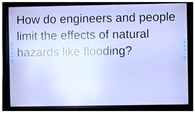 | Holly fosters their prior knowledge about how the effects of natural hazards are limited: “How do engineers and people limit the effects of natural hazards like flooding? So, you’re going to write the question and write any initial thoughts you have right now. Remember, scientists change their thinking.” (Lesson 8, 00:15:59) |
| PRDCT | 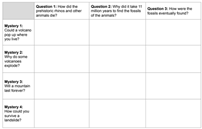 | Holly asks students to write their predictions to the third question on the worksheet and asks “you’ll make a prediction for Question Three about how you think the fossils were eventually found.” (Lesson 7, 00:09:58) |
| QS | 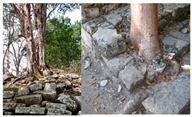 | Holly and the students discuss erosion. Holly asks the students to think about what happened to the pyramid in the pictures on the left. |
| Codes | Screenshot | Description and Transcription |
|---|---|---|
| MoI | 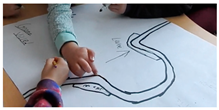 | Holly: “You have to put together a plan to keep people safe in the event of a flood based on the river that you’re doing. Here’s your list of things that you have to have. You have to have your river drawn neatly in the middle of your paper. You need to place houses where they will be the most safe. You need to label any modifications made to your house or river. So for example, if you’re putting a levy down, you need to have that clearly labeled. And if you’re building your house on fill or stilts or something like that, you need to have that labels. And then you have to explain how your plan will keep people safe.” (Lesson 12, 00:46:00). |
| Codes | Description and Transcription |
|---|---|
| MoI | Holly: “I don’t know if you remember; this has been a while. We did a social studies activity about this at the very beginning of the year. We looked at places in [State] where people settled when settlers first came over and we talked about how they were all in areas where there was water close by because they needed that. At a certain point, you know, we couldn’t just have, we didn’t have plumbing systems; we couldn’t bring in water. So, we had to settle in areas near water so that we had access to that, or we had access to things like fish or food or water that we could water crops with. So, there’s many reasons why people might choose to live in a floodplain or they’ve had houses or land there for a long time. So now one of the things that we do is we look at how can we limit some of the effects of flooding.” (Lesson 10, 00:09:12). |
| BRAIN1 | Holly: “We were having a conversation about how flooding really becomes an issue; when we have people involved or people’s houses or people’s structures. So sometimes there are natural hazards that happen that can actually be good for the environment too. So, in this case, and then the other thing maybe in [Town]…was that you don’t want to go and start making a bunch of changes to the land that you don’t need to do, right?” |
Disclaimer/Publisher’s Note: The statements, opinions and data contained in all publications are solely those of the individual author(s) and contributor(s) and not of MDPI and/or the editor(s). MDPI and/or the editor(s) disclaim responsibility for any injury to people or property resulting from any ideas, methods, instructions or products referred to in the content. |
© 2023 by the authors. Licensee MDPI, Basel, Switzerland. This article is an open access article distributed under the terms and conditions of the Creative Commons Attribution (CC BY) license (https://creativecommons.org/licenses/by/4.0/).
Share and Cite
Boz, T.; Hammack, R.; Lux, N.; Gannon, P. Empowering Elementary Students with Community-Based Engineering: A Teacher’s Experience in a Rural School District. Educ. Sci. 2023, 13, 434. https://doi.org/10.3390/educsci13050434
Boz T, Hammack R, Lux N, Gannon P. Empowering Elementary Students with Community-Based Engineering: A Teacher’s Experience in a Rural School District. Education Sciences. 2023; 13(5):434. https://doi.org/10.3390/educsci13050434
Chicago/Turabian StyleBoz, Tugba, Rebekah Hammack, Nicholas Lux, and Paul Gannon. 2023. "Empowering Elementary Students with Community-Based Engineering: A Teacher’s Experience in a Rural School District" Education Sciences 13, no. 5: 434. https://doi.org/10.3390/educsci13050434
APA StyleBoz, T., Hammack, R., Lux, N., & Gannon, P. (2023). Empowering Elementary Students with Community-Based Engineering: A Teacher’s Experience in a Rural School District. Education Sciences, 13(5), 434. https://doi.org/10.3390/educsci13050434






